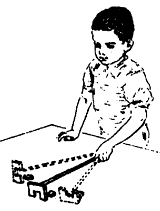Miller Umwelt Assessment Scale TM
Von Uexkull, J. von (1934/1957). A stroll through the worlds of animals and
men. In C. Schiller (Ed.), Instinctive Behavior (pp. 5-80). New York:
International Universities Press.
An Umwelt, following Uexküll's (1934/1957) use of the term refers to the subjective "world around one." Applied to behavior-disordered children, it refers to the unique reality constructed by each child and within which the child functions.
The Miller Umwelt Assessment Scale (MUASC), therefore, is an effort to sort out the nature of this reality in order to introduce the interventions most helpful in resolving that particular child's reality problems. The MUASC kit manual, forms, videotape introduces those tasks that over the years have been most helpful in this regard.
For example, in the most expanded reality of the Swinging Ball task, (see Figure 1) the child notices the adult repetitively swinging a ball toward him or her and enters into a game whereby the two alternately push the swinging ball back and forth.

Figure 1
However, a child who has not achieved this most expanded reality may show a more circumscribed reality system, and push the ball away each time it comes without noticing the adult who is sending it. Finally, most removed, a child may not notice or react to the ball even when it collides with the body. In similar fashion, each of the tasks lend themselves to solutions involving more restricted as well as more expanded reality systems. Thus, the examiner is interested not only in the "correctness" of the child's solution, but in how it helps characterize his or her unique way of making sense of and coping with the world.
A proper assessment of the kinds of systems these children possess and how these systems fail to bring them into adaptive contact with their surroundings permits planning interventions most likely to help them develop expanded Umwelten within which they can perform and grow.
Selecting Tasks for the Umwelt Assessment
We have selected 16 tasks so that the examiner can assess the shift from the most circumscribed reality to more expanded realities. In addition, there is a "testing limits" procedure that not only suggests how far the child is from being able to participate in more expanded realities, but also indicates how useful such testing limits procedures are as interventions.
The tasks involve relatively familiar situations that require the child to cope with a Swinging Ball moving toward him or her, with climbing up steps, and with walking across, climbing over or around various obstacles.
The tasks also entail dealing with a step-slide arrangement; blocks; using rakes to get objects, both with and without the interference of obstacles; and cups and bowls that must be stacked in a variety of ways.

Other tasks involve symbolic play, picture recognition, reading and number capacity, and awareness of people.
The expandable nature of each task becomes apparent as a child interacts with it and the person introducing it.
The areas of a child's developmental status that the Umwelt Assessment helps clarify are body schema development, coping with the environment, social contact and representation/ communication. Once the child's status in each of these areas becomes clear, the teacher or clinician can readily plan interventions that are relevant for that child.
The MUASC Kit contains:
- Packet of forms (copyable)
- Examiner's Manual
- VHS Training Videocassette
| 
